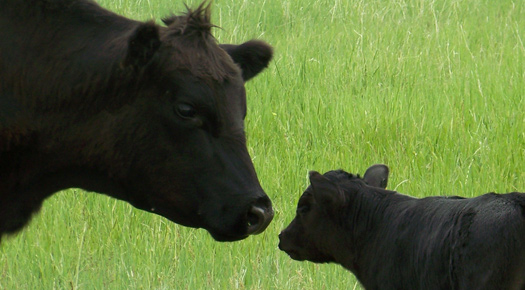
Agricultural News
How Many Heifers to Keep?
Wed, 15 Dec 2010 7:49:03 CST
 Much is currently being written about the need to re-grow the nation's cow herd. Individual ranches must make the decisions about heifer retention based upon factors that directly affect their bottom-line.
Much is currently being written about the need to re-grow the nation's cow herd. Individual ranches must make the decisions about heifer retention based upon factors that directly affect their bottom-line.
Matching the number of cattle to the grass and feed resources on the ranch is a constant challenge for any cow-calf producer. Also producers strive to maintain cow numbers to match their marketing plans for the long term changes in the cattle cycle. Therefore it is a constant struggle to evaluate the number of replacement heifers that must be developed or purchased to bring into the herd each year. As a starting place in the effort to answer this question, it is important to look at the "average" cow herd to understand how many cows are in each age category. Dr. Kris Ringwall, director of the Dickinson, North Dakota Research and Extension Center recently reported on the average number of cows in their research herd by age group for the last 20 years.
Ringwall's research indicates that the typical herd will, "on the average", introduce 17% new first calf heifers each year. Stated another way, if 100 cows are expected to produce a calf each year, 17 of them will be having their first baby. Therefore this gives us a starting point in choosing how many heifers we need to save each year.
Next, we must predict the percentage of heifers that enter a breeding season that will become pregnant. The prediction is made primarily upon the nutritional growing program that the heifers receive between weaning and breeding. Researchers many years ago, found that only half of heifers that reached 55% of their eventual mature weight were cycling by the time they entered their first breeding season. This data was reinforced with recent data from Oklahoma State Unviersity's Animal Science Department. If these heifers were exposed to a bull for a limited number of days (45-70), not all would have a chance to become pregnant during that breeding season. Therefore, it would be necessary to keep an additional 50% more heifers just to make certain that enough bred heifers were available to go into the herd. However if the heifers were grown at a more rapid rate and weighed 65% of their eventual mature weight, then 90% of them would be cycling at the start of the breeding season and a much higher pregnancy rate would be the result. Click here for details of the study done at OSU on this.
Even in the very best scenarios, some heifers will be difficult or impossible to breed. Most extension specialists and researchers write about the need to always expose at least 10% more heifers than you need even when they are grown properly and all weigh at least 65% of the expected mature weight.
The need to properly estimate the expected mature weight is important in understanding heifer growing programs. Cattle type and mature size has increased over the last half century. Rules of thumb that apply to 1000 pound mature cows very likely do not apply to your herd. Watch sale weights of culled mature cows from your herd to better estimate the needed size and weights for heifers in your program. Most commercial herds have cows that average about 1150 pounds or more. This requires that the heifers from these cows must weigh at least 747 pounds at the start of their first breeding season to expect a high percentage to be cycling when you turn in the bulls.
This discussion is meant to be a STARTING PLACE in the decision to determine the number of heifers needed for replacements. Ranchers must keep in mind the over-riding need to understand where forage base resources that they have available to them.
Source: Dr. Glenn Selk, Animal Science Department of Oklahoma State University- or thanks for Dr. Selk for authoring this article from his weekly email update, Cow-Calf Corner.
WebReadyTM Powered by WireReady® NSI
Top Agricultural News
More Headlines...



















